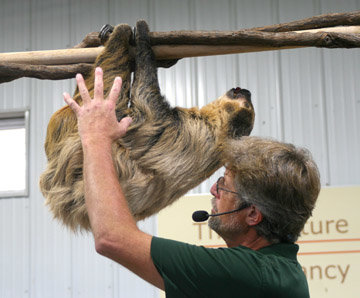
MSU’s Broad Art Museum has given Poco a compelling reason to bestir himself, climb into his cozy sleep barrel and make the trip down I-96 from his home in Ann Arbor to East Lansing.
Long Island artist Steve Miller’s “Sloth Pieta,” a heavy, temperedglass X-ray image of a mother sloth and her baby, is among the most striking and unusual works tucked into the sculpture garden just east of the museum.
In a strange encounter between fragile life and enduring art, Poco will meet visitors to the museum Aug. 13.
Miller’s stark image refers to the many “Pietas” of art history, with the dead Christ in the arms of the Virgin Mary, while calling attention to the worldwide loss of wildlife habitat and species extinction.
Empathy for the sacrifice of innocent life is the common thread. Sloths spend their lives hanging upside down from trees, as high as 100 feet in the air, sleeping 18 hours a day and barely moving most of the time. That makes them especially vulnerable to habitat loss, according to Steve Marsh, curator of Ann Arbor’s Creature Conservancy.
“When a section of rain forest is chopped down, jaguars can move out of the way,” Marsh said. “Sloths end up going down with the forest. They’re in those trees.”
If empathy is the purpose of art, Marsh is as much an artist as Miller. Marsh has found that the sight of Poco and a touch of his fur puts a strangely ecstatic face on kids and adults alike.
“Jaguars and alligators are magnificent beasts, but they can also rip us to shreds,” Marsh said. “There tends to be a little more empathy to the placid plant-eaters.”
He paused as a furious honking erupted behind him.
“Sorry, that’s the warthog.” The Creature Conservancy provides shelter and habitat for rescued animals the Humane Society can’t handle, most of them abandoned exotic pets. Among the current inhabitants are seven sloths, a warthog, a jaguar, an albino alligator, parrots, ostriches, a tortoise and many more creatures.
A lot of the animals are more active than ultra-slow Poco, but when it comes to star power, the last shall be first.
“People are drawn to sloths,” Marsh said. “Sloth Month is our most popular month here.”
When Marsh brings Poco to groups of kids and adults, he concentrates on the adaptations that make sloths so well suited to their rain forest world, like reversed hair follicles and fur that hangs down and channels the rain off their bodies.
The ecological message comes mostly from the impact of encountering such a strange, placid animal in the flesh.
But Miller isn’t shy about pointing out the explicit connection between the Pietas of the Renaissance, portraying Mary’s sadness at the death of Christ, and the ongoing slaughter of innocents in the world’s disappearing rain forests.
“These guys are dying for our sins,” Miller told the online magazine Hamptons Art Hub in September 2014.
Miller became fascinated with rainforests after attending an art exhibition in Brazil. With its staggering capacity to absorb carbon dioxide, the vast, heavily forested Amazon basin is often called “the lungs of the planet.” Miller seized upon the idea of X-raying those “lungs,” as a doctor would examine a sick patient, by X-raying its fantastic fauna.
He teamed up with radiologists in Belém, a Brazilian city whose name, coincidentally, is Portuguese for Bethlehem. The largest city on the Amazon River, Belém is home to a fishery, an aviary and a zoo. Miller and the radiologists X-rayed a variety of rainforest dwellers, from piranhas to alligators. The female sloth in “Sloth Pieta” was near death when her image was taken.
When Marsh heard the Broad was looking for a real sloth to make a joint appearance with Miller’s sculpture, he jumped at the chance. Marsh, who studied art in college, has never taken Poco to an art museum.
“I’ve been doing this for 26 years, so this is an unusual thing,” he said. “Apparently there’s not enough pieces of art about animals. Maybe we need to change that.”
Art history has not exactly been kind to animals. The world’s galleries are full of pictures of aristocrats trotting off to the hunt, whales being harpooned, tables piled with goggle-eyed fowl and rabbits and so on. “Sloth Pieta” reflects a new phase of brutality — the large-scale loss of habitat — but also a new phase of empathy.
“I can’t think of any other piece of art that tries to do the same thing,” Marsh said.
While many Creature Conservancy animals don’t travel well, that’s not a problem for most sloths. Friday afternoon, Marsh will nestle Poco into a special barrel with blankets on the bottom and a grid of sticks on top for secure hanging.
“These animals sleep 18 hours a day, and they have vehicular narcolepsy,” Marsh said. “He chills out and goes to sleep, we drive up there, pull him out and hang him on a branch. We couldn’t do that with most of our animals. We’d never take the warthog that far.”
Poco likes to listen to ‘80s music while traveling.
“He needs a clear, even beat,” Marsh said, almost apologetically. “I know art people like jazz, but it’s too frenetic for him.”
Altered tour: “Sloth Pieta”
7 p.m. Friday, Aug. 13 (Event is at capacity but will be streamed live at facebook. com/broadmsu.) Eli and Edythe Broad Art Museum 547 E. Circle Drive, East Lansing (517) 884-4800, broadmuseum.msu.edu
Support City Pulse - Donate Today!
Comments
No comments on this item Please log in to comment by clicking here